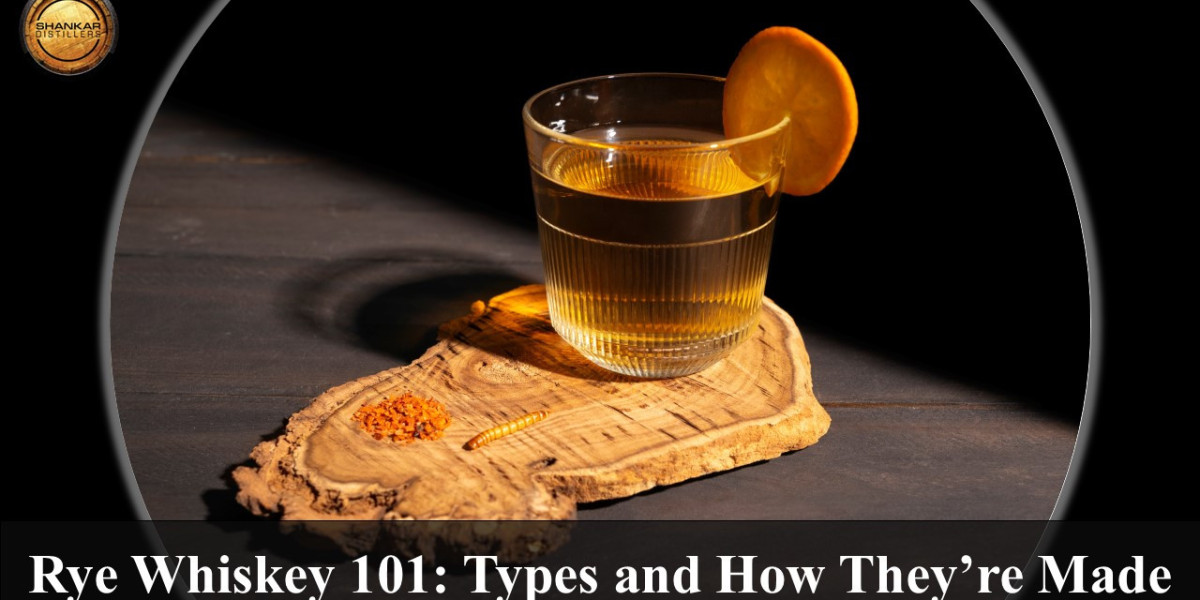Rye whiskey, a spirit with a storied past and vibrant flavor profile, has seen a resurgence in popularity among whiskey enthusiasts. Known for its distinct spiciness and bold character, rye whiskey offers a unique alternative to other whiskies and has become a staple in the whiskey collection of many. As interest in this spirited category continues to grow, it's helpful to understand the different types of rye whiskey and the process that gives them their iconic character. For those seeking to explore the finest rye whiskey options, Rye Whiskey Distillers in the USA have set a benchmark for quality and craftsmanship, bringing out the unique essence of this time-honored spirit. To further appreciate rye whiskey, let’s delve into its types, explore the various methods of production, and discover why it’s an ideal choice for rye whiskey recipes from Shankar Distillers.
Types of Rye Whiskey
Rye whiskey varies significantly based on the country of origin, production method, and even aging techniques. Here’s a breakdown of some of the primary types you might encounter:
1. American Rye Whiskey
American rye whiskey is known for its robust flavors and strict production standards. To be labeled as rye whiskey in the United States, the spirit must be made from at least 51% rye grain. This high rye content gives it a spicier, more pronounced flavor compared to bourbons, which predominantly use corn. American rye must also be aged in new, charred oak barrels, which lend notes of caramel, vanilla, and oak, enhancing its bold flavor profile. This combination of spicy rye and smooth oak makes American rye a popular choice for whiskey connoisseurs and mixologists alike.
2. Canadian Rye Whiskey
In Canada, the regulations surrounding rye whiskey are a bit more flexible, allowing for a broader range of styles and flavors. Interestingly, Canadian law allows whisky to be labeled as “rye” even if it doesn’t contain a high percentage of rye grain. This has led to a wide array of Canadian rye whiskies, from those that embody the traditional spiciness to softer, more versatile styles. While Canadian rye whiskies may vary in taste, they are often noted for their smooth, approachable character and are ideal for both sipping and mixing in classic rye whiskey cocktails.
3. Single Barrel Rye Whiskey
Single-barrel rye whiskey offers a unique experience for those seeking distinct flavors. Unlike standard blends, where whiskies from multiple barrels are combined to achieve a consistent flavor, single-barrel rye whiskey is drawn from a single barrel, capturing the unique characteristics of that individual barrel. This approach often results in more complex, layered flavors that can vary from one barrel to the next, offering a special tasting experience for enthusiasts. The rich, nuanced flavors found in single-barrel rye whiskies are highly sought after, making them a favorite among collectors and aficionados.
4. Small-Batch Rye Whiskey
Small-batch rye whiskey refers to a production method that uses a limited number of barrels. This type of rye whiskey typically showcases a more crafted approach, with distillers often experimenting with various mash bills, aging conditions, or blending techniques. The smaller production scale allows for more control over the final product, often resulting in a higher-quality whiskey with distinctive flavors. Small-batch rye whiskey is especially popular among artisan distilleries looking to offer a unique take on the traditional rye profile.
Production Process: How Rye Whiskey is Made
The production of rye whiskey follows a precise process that influences its taste, aroma, and texture. While each type of rye whiskey may undergo slight variations in production, the following steps are commonly used across the board:
1. Mashing
The process of creating rye whiskey begins with mashing, where the grain (predominantly rye) is mixed with water and heated. This allows enzymes to convert the starches in the grain into fermentable sugars. For American rye whiskey, the mash bill must consist of at least 51% rye, while the remainder typically includes corn and malted barley. Canadian rye whiskey, on the other hand, may use different proportions depending on the desired flavor profile.
2. Fermentation
After mashing, the liquid is cooled, and yeast is added to initiate fermentation. The yeast consumes the sugars and produces alcohol along with various aromatic compounds that contribute to the whiskey’s flavor. This stage typically lasts several days and results in a fermented liquid known as the "wash," which has a relatively low alcohol content but is rich in flavor compounds.
3. Distillation
The fermented wash is then distilled, usually in copper stills. Distillation separates the alcohol from the water, concentrating the flavors and increasing the alcohol content. Many distilleries use pot stills for smaller batches to achieve a richer, more complex flavor, while column stills are often used in larger-scale production for a smoother, more consistent spirit.
4. Aging
Aging plays a significant role in shaping the final character of rye whiskey. In the United States, rye whiskey must be aged in new, charred oak barrels, which impart color and flavor to the spirit. The aging process can last from a few years to over a decade, with longer aging resulting in a more mature, rounded whiskey. The charred oak barrels not only add flavor but also help filter out impurities, resulting in a cleaner taste profile. Canadian rye whiskey may be aged in a wider variety of barrels, which allows for a different range of flavors, including softer, more subtle notes.
5. Bottling
After aging, rye whiskey is filtered and diluted to the desired bottling strength, typically around 40% alcohol by volume (ABV). Some single-barrel and small-batch whiskies may be bottled at cask strength, offering a more intense flavor. At this point, the whiskey is ready to be enjoyed, whether on its own or as a base for various rye whiskey recipes.
Conclusion: The Distinct Appeal of Rye Whiskey
Rye whiskey’s distinct character and versatile flavor make it an exciting spirit for both new whiskey drinkers and seasoned aficionados. Its spicy, bold profile stands out in cocktails, yet it’s complex enough to be enjoyed on its own. With various types and styles, from the classic American and Canadian versions to unique single-barrel and small-batch offerings, there’s a rye whiskey for every palate. Rye whiskey recipes from Shankar Distillers exemplify the versatility and depth that rye whiskey can bring to a drink, making it a beloved choice for both cocktail enthusiasts and traditionalists.
For those looking to explore the rich tradition and vibrant flavors of rye whiskey, consider reaching for a bottle crafted by Shankar Distillers - Premium Whiskey Distillers. Whether you’re savoring it neat or mixing it into a cocktail, rye whiskey is an experience that connects the past with the present, offering a taste that’s truly timeless.
Useful Links








